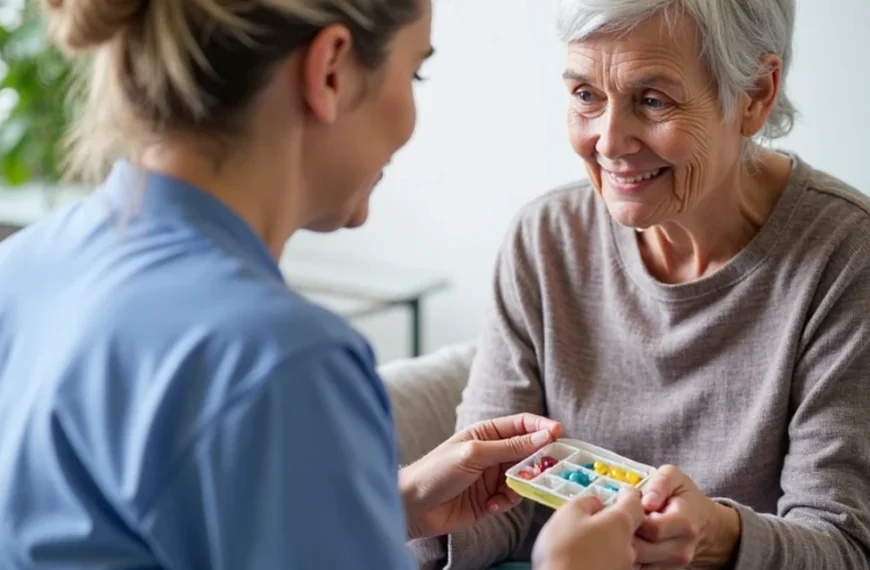Walking into a new client’s home for the first time as a caregiver is both an exciting opportunity and a significant responsibility. The preparation you undertake before that initial visit can set the foundation for a successful professional relationship, effective care delivery, and a sustainable caregiving business.
As Maria, a caregiver with over 15 years of experience, shared with me, “My preparation routine before meeting a new client is as important as the care itself. When I arrive prepared, I show the client and their family that I value their time and take my responsibilities seriously.”
Pre-Visit Preparation: Setting Yourself Up for Success
Establishing Initial Client Communication
Before you step foot in a client’s home, make direct contact to confirm critical details. A phone call or video chat allows you to introduce yourself, verify the care schedule, and discuss payment terms clearly. This initial conversation also presents an opportunity to request essential information about medical conditions, medications, mobility challenges, and daily routines.
James, who transitioned from hospital nursing to home care three years ago, advises, “I always ask if there are specific house rules I should be aware of—pets, visitors, parking arrangements—those small details make a big difference in how smoothly that first visit goes.”
Create a simple pre-visit questionnaire that you can complete during this conversation, covering:
- Primary care needs and priorities
- Medical history highlights and current concerns
- Medication schedules and assistance required
- Dietary restrictions or preferences
- Mobility level and transfer assistance needed
- Daily routine and preferred schedule
- Emergency contacts and protocols
Keep detailed notes from this conversation to reference during your first visit. One technique that works well is sending a follow-up email summarizing what you discussed, which gives the client opportunity to clarify any misunderstandings before you arrive.
Credential and Insurance Verification
As an independent caregiver, your professional credentials are your calling card. Before your visit, organize copies of all relevant certifications:
- Caregiver or CNA license/certification (PSW, HSW, HCA, CNA, HHA, LPN, etc.)
- CPR and First Aid certification
- Specialized training certificates (dementia care, hospice care, etc.)
- Background check documentation
- References from previous clients (with permission)
If you carry personal liability insurance or are bonded—highly recommended for independent caregivers—have proof readily available. Many families will specifically request this documentation, and having it organized demonstrates your professionalism.
“I keep digital and physical copies of all my credentials in a professional portfolio,” explains Sophia, who has worked as an independent caregiver for eight years. “Being able to promptly share these documents when requested has helped me secure several long-term clients who appreciate my transparency and organization.”
Personal Supply Preparation
A well-stocked caregiver kit is essential for your professional practice. While clients typically provide major supplies, having your own basics ensures you’re prepared for any situation.
Your personal caregiver kit might include:
- Personal protective equipment (gloves, masks, hand sanitizer)
- Backup medical supplies (blood pressure cuff, pulse oximeter)
- Basic first aid supplies
- Personal hygiene items
- Notebook and pen for documentation
- Digital thermometer
- Extra scrubs or uniform in case of soiling
- Comfortable, supportive shoes
- Snacks and water for yourself
“My caregiver tote has saved the day countless times,” shares Thomas, who specializes in post-surgical home care. “From having extra gloves when a client ran out to being able to document vital signs when their equipment malfunctioned—being prepared has helped me provide uninterrupted care even when unexpected situations arise.”
Logistical Planning
Nothing undermines a first impression like arriving late or flustered. Map your route to the client’s home in advance, accounting for typical traffic patterns at your scheduled arrival time. Consider doing a practice run if the location is in an unfamiliar area with complex navigation.
Calculate travel expenses and factor them into your pricing structure if applicable. Be transparent about any travel fees during your initial discussions. Some caregivers charge a flat travel fee, while others build the cost into their hourly rate depending on distance.
Understanding Your Client’s Unique Needs
Reviewing Self-Gathered Information
Before your first visit, thoroughly review any information you’ve already collected about your client. Create a care profile that organizes what you know about:
- Primary diagnosis and secondary health concerns
- Cognitive status and communication abilities
- Mobility limitations and transfer requirements
- Personal care needs and preferences
- Medication management expectations
Identify knowledge gaps and prepare specific questions to fill these gaps during your first visit. Having these questions ready demonstrates your thoroughness and commitment to personalized care.
Clarifying Scope of Work
Misunderstandings about the scope of care can lead to frustration for both caregivers and clients. Before your first visit, develop a clear written outline of:
- Personal care tasks you will provide
- Household tasks within your responsibility
- Medical monitoring or medication assistance included
- Transportation or errands if applicable
- Companion care components
Be equally clear about what services fall outside your scope, such as:
- Heavy lifting or major home cleaning
- Administration of certain medications
- Medical procedures requiring specialized training
- Home repairs or maintenance
“The clearest contracts make for the happiest clients,” advises Elena, who’s built a successful independent caregiving business. “I provide a detailed service agreement that outlines exactly what care I provide and what falls outside my scope. This prevents misunderstandings and protects both me and my clients.”
Equipment Familiarity
Ask about any specialized equipment you’ll need to operate in the client’s home. If the client uses equipment you’re unfamiliar with—such as a particular model of hospital bed, lift equipment, or feeding systems—research proper usage before your visit.
Many equipment manufacturers offer tutorial videos online. Alternatively, contact your local home healthcare supply store, which may offer quick training sessions for caregivers. Being knowledgeable about equipment demonstrates your commitment to providing safe, effective care.
Professional Readiness: Business Aspects of Caregiving
Business Preparedness
As an independent caregiver, you’re not just a care provider—you’re a small business owner. Prepare the business aspects of your service with the same attention you give to care planning:
- Bring printed copies of your service contract or agreement
- Have clearly outlined payment terms and methods
- Prepare invoices or receipts
- Consider bringing business cards or brochures
- Have tax documentation ready if required
“When I started as an independent caregiver, I focused entirely on the care aspects and neglected the business side,” admits Carlos, who now manages a small team of caregivers. “I learned quickly that professional business practices are equally important for long-term success and client satisfaction.”
Professional Appearance and Attitude
Your appearance and demeanor create critical first impressions. Dress professionally in clean, appropriate attire—typically scrubs or a professional uniform. Ensure your appearance is neat, with minimal jewelry, clean, short nails, and hair styled appropriately for care work.
Beyond physical appearance, cultivate a professional attitude that balances warmth with boundaries. Approach each new client with genuine empathy and curiosity about their needs, while maintaining the professional boundaries necessary for sustainable caregiving.
“My approach is ‘professionally personal,'” explains Denise, who specializes in end-of-life care. “I genuinely care about my clients and show compassion, but I also maintain clear professional boundaries that protect both of us in the caregiving relationship.”
Communication Skills Preparation
Prepare a brief professional introduction that you can adapt for each client. This might include:
- Your caregiving experience and background
- Relevant certifications and specializations
- Your caregiving philosophy or approach
- How you prefer to communicate (texting, calling, email)
Practice active listening techniques that will help you understand client needs during your first visit. Remember that some clients or family members may be stressed, anxious, or overwhelmed when you arrive. Your calm, confident communication can help ease these tensions.
Making a Positive First Impression
Arrival and Initial Interaction
Arrive 5-10 minutes early to demonstrate punctuality without imposing on the client’s time. Present yourself professionally with a warm greeting, and be prepared to show your identification and credentials if requested.
If a formal contract wasn’t signed before your arrival, review the agreement together and address any questions before beginning care. This conversation sets the tone for clear communication throughout your working relationship.
“That first meeting sets the foundation for everything that follows,” shares Rachel, who’s been providing in-home care for over a decade. “I always bring a small notebook where I jot down client preferences during our initial conversation—everything from how they prefer to be addressed to how they like their tea prepared. Those small details make clients feel truly seen and respected.”
Home Familiarization
Request a thorough tour of the home environment, paying particular attention to:
- Where care will primarily be provided
- Bathroom locations and accessibility features
- Kitchen organization and meal preparation areas
- Emergency exits and safety equipment
- Where to store your personal belongings
- Location of client supplies and equipment
During this tour, mentally note potential safety concerns or accessibility issues that might affect care delivery. Ask where you can store your personal supplies while working.
Day-of Task Confirmation
Begin your first day by reviewing priorities with your client or their family member. Ask specific questions about routines and preferences:
- “What would you like me to focus on first today?”
- “Could you show me exactly how you prefer this task to be done?”
- “What’s most important to you about how I provide this care?”
Document these preferences for future reference. Many caregivers maintain a client care notebook where they record important details about each client’s care.
Adapting to Your New Environment
Safety Assessment
While touring the home, conduct a mental safety assessment for both your client and yourself:
- Check for trip hazards like loose rugs or electrical cords
- Note any challenging transfers or physical spaces
- Identify potential ergonomic concerns for caregiving tasks
- Locate fire extinguishers and emergency exits
- Observe general home maintenance issues that might pose risks
If you notice significant safety concerns, diplomatically discuss them with the client or family. Frame suggestions constructively: “I notice the bathroom doesn’t have grab bars. Would you be interested in hearing about some affordable options that might make transfers safer for both of us?”
Building Initial Rapport
The first day with a new client is about providing care while building trust. Engage in appropriate conversation that helps you understand their preferences, interests, and personality. Be attentive to cues about how much conversation they enjoy—some clients prefer quiet companionship while others value social interaction.
Demonstrate respect for privacy, cultural practices, and personal boundaries. Ask permission before entering private spaces or handling personal belongings. These small courtesies help establish trust.
“Building rapport isn’t about forced cheerfulness,” notes William, who specializes in dementia care. “It’s about genuine respect and interest in the person. I always ask about family photos or mementos in the home—it gives clients a chance to share something meaningful to them and helps me understand what matters in their life.”
Flexibility and Adaptability
No matter how thorough your preparation, expect the unexpected during your first visit. Clients may have additional needs not previously discussed, or their condition might differ from what was described. Approach these situations with flexibility while being mindful of your scope of practice and agreed-upon duties.
If unexpected requests arise, calmly discuss whether they fall within your role and skillset. If necessary, negotiate adjustments to your agreement to accommodate additional needs.
Post-Visit Follow-Up: Establishing Ongoing Excellence
Documentation Practices
After completing your first visit, document everything while it’s fresh in your mind:
- Care provided and client’s response
- Observations about health status or concerns
- Tasks completed and those requiring attention next visit
- Questions that arose during care
- Hours worked and services provided
- Supplies that need replenishment
If providing a written care summary for family members, focus on factual, professional observations rather than opinions or judgments.
Self-Reflection for Improvement
Take time to reflect on your first visit experience:
- What went well? What was challenging?
- Were there any skills or knowledge gaps you need to address?
- Did you have all the supplies and equipment needed?
- How was the interpersonal dynamic with the client?
- Were the agreed-upon tasks realistic within the time allotted?
Use these reflections to make adjustments to your care approach, supply kit, or business practices for future visits.
Client Communication Follow-Up
After your first visit, a brief follow-up communication demonstrates professionalism and commitment:
- Thank the client for welcoming you into their home
- Confirm your next scheduled visit
- Address any questions that arose during your visit
- Invite feedback about your care
This follow-up can be a phone call, text message, or email, depending on the client’s preference.
“That post-visit check-in is something many caregivers skip, but it makes a tremendous impression,” says Jared, who built his caregiving business primarily through referrals. “It shows you’re thinking about the client beyond the billable hours and gives them an opening to share concerns they might have been hesitant to mention in person.”
Business Management
Update your business records promptly after each visit:
- Record payment received or invoice sent
- Update client care plans based on new information
- Schedule any follow-up tasks (e.g., researching a resource for the client)
- Track mileage and expenses for tax purposes
If appropriate and with client permission, request referrals or reviews that can help build your business. Many independent caregivers build their practice entirely through word-of-mouth from satisfied clients.
Building a Sustainable Caregiving Practice
The preparation you invest before and after each client visit contributes to more than just that specific caregiving relationship—it builds the foundation for a sustainable, rewarding caregiving career.
Successful independent caregivers balance clinical skills with business acumen. They recognize that thorough preparation, clear communication, and professional follow-through are as important as the hands-on care they provide.
As you develop your practice, continuously refine your preparation process. What worked with one client may need adjustment for another. The toolkit you bring may evolve based on your clientele’s needs. The questions you ask during pre-visit consultations may become more targeted as you gain experience.
By approaching each new client with thorough preparation, professional presentation, and genuine care, you position yourself for success while providing the quality support your clients deserve.





